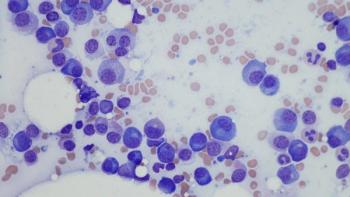
DNA Test Outperforms PET/CT Scans When Detecting Lymphoma

Key Takeaways
- The Foresight CLARITY test offers greater prognostic accuracy than PET/CT scans in large B-cell lymphoma by detecting ctDNA-MRD negativity, indicating better patient outcomes.
- ctDNA-MRD testing showed a 2-year progression-free survival of 97% for MRD-negative patients, compared to 29% for MRD-positive patients.
ctDNA-MRD testing better predicted outcomes versus PET/CT scans for large B-cell lymphoma, leading to NCCN guideline updates for remission assessment.
A minimal measurable residual disease (MRD) analysis using the Foresight CLARITY test provided greater prognostic accuracy than PET/CT scans in patients with large B-cell lymphoma (LBCL), according to a news release from Foresight Diagnostics.
"These findings highlight the clinical value of achieving circulating tumor DNA (ctDNA)-MRD negativity at the end of treatment and underscore the limitations of relying solely on PET/CT for remission assessment," Dr. David Kurtz, chief medical officer at Foresight Diagnostics and co-author on the analysis, said in the news release. "With the ultra-high sensitivity of Foresight CLARITY™, we can detect disease that imaging misses, offering clinicians a more accurate and actionable tool for post-treatment risk stratification."
Notably, ctDNA, also known as circulating tumor DNA, according to the Dana-Farber Cancer Institute website, is a kind of DNA which is released into the bloodstream, and can be detected; these detectable DNA cells come from cancer cells.
Can ctDNA-MRD Testing More Accurately Predict Outcomes in B-Cell Lymphoma Compared With PET/CT?
Study findings were published in the Journal of Clinical Oncology. A blood-based test called ctDNA-MRD was able to show how patients were responding to chemotherapy as early as after two treatment cycles. At that point, patients whose test showed no remaining cancer (undetectable MRD) had a 2-year progression-free survival (the time patients live without their cancer worsening) of 96%, compared with 67% for those whose test showed remaining cancer.
The test was even more accurate at the end of therapy. At this time, 78% of patients were MRD-negative, and they had a 2-year progression-free survival of 97%. In contrast, only 29% of MRD-positive patients remained progression-free at 2 years. For comparison, imaging with PET/CT was less able to predict patient outcomes.
Furthermore, MRD results gave additional insight beyond what imaging showed. Patients with detectable MRD had a higher chance of relapse even if their scans looked clear, while patients with undetectable MRD had better outcomes even if their scans suggested cancer remained.
In total, the Foresight CLARITY test showed 86% sensitivity for detecting relapse and 91% specificity for confirming remission, based on a median follow-up of 37 months.
"Our study illustrates the potential of ctDNA-MRD detection to more precisely define remission in B-cell lymphoma," Dr. Mark Roschewski, senior clinician and deputy branch chief of the Lymphoid Malignancies Branch at the Center for Cancer Research and lead author of the publication, said in the news release. "The results support the incorporation of novel surrogate endpoints such as molecular response into prospective studies evaluating how they could aid clinical decisions following frontline therapy."
These results from this pooled analysis were included in Foresight’s clinical recommendations to the National Comprehensive Cancer Network (NCCN). These findings supported the December 2024 update to the NCCN Clinical Practice Guidelines in Oncology for B-cell lymphomas. The update incorporated ctDNA-MRD testing as a tool to help interpret PET-positive scans at the end of therapy.
What Trials Are Evaluating ctDNA-Guided Treatment Decisions?
Ongoing studies are testing whether blood-based ctDNA results can help guide treatment decisions for B-cell lymphoma. The ALPHA3 study is enrolling patients whose cancer goes into remission after initial treatment but still have signs of ctDNA in their blood. Another study, called SHORTEN-ctDNA, is exploring whether early clearance of ctDNA could be used as a marker to safely reduce the intensity of chemotherapy.
What is a PET/CT Scan?
A PET-CT scan is a procedure that combines images from a positron emission tomography (PET) scan and a computed tomography (CT) scan, taken at the same time with one machine, according to the National Cancer Institute’s website, cancer.gov.
Together, these scans provide more detailed pictures of areas inside the body than either test alone. PET-CT scans may be used to help diagnose conditions such as cancer, guide treatment planning, or check how well treatment is working. It is also called a positron emission tomography-computed tomography scan.
References
- “Foresight Diagnostics Announces Publication of Landmark Study Demonstrating Prognostic Value of Ultrasensitive ctDNA-MRD Detection in Large B-Cell
- "What Is ctDNA," by Rob Levy. Dana-Farber Cancer Institute. June 26, 2023.
- Lymphoma,” Foresight Diagnostics. News Release. Aug 18, 2025.
- “Remission Assessment by Circulating Tumor DNA in Large B-cell Lymphoma,” by Dr. Mark Roschewski, et al. Journal of Clinical Oncology.
For more news on cancer updates, research and education,




